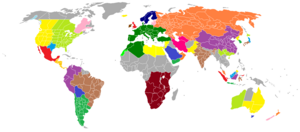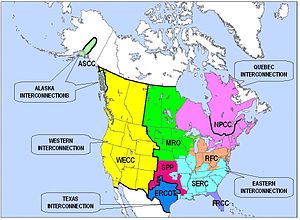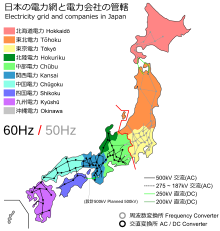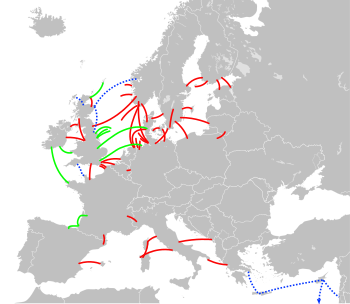
Electric power transmission is the bulk movement of electrical energy from a generating site, such as a power plant, to an electrical substation. The interconnected lines that facilitate this movement form a transmission network. This is distinct from the local wiring between high-voltage substations and customers, which is typically referred to as electric power distribution. The combined transmission and distribution network is part of electricity delivery, known as the electrical grid.

The electric power industry covers the generation, transmission, distribution and sale of electric power to the general public and industry. The commercial distribution of electric power started in 1882 when electricity was produced for electric lighting. In the 1880s and 1890s, growing economic and safety concerns lead to the regulation of the industry. What was once an expensive novelty limited to the most densely populated areas, reliable and economical electric power has become an essential aspect for normal operation of all elements of developed economies.

The utility frequency, (power) line frequency or mains frequency is the nominal frequency of the oscillations of alternating current (AC) in a wide area synchronous grid transmitted from a power station to the end-user. In large parts of the world this is 50 Hz, although in the Americas and parts of Asia it is typically 60 Hz. Current usage by country or region is given in the list of mains electricity by country.

The National Grid is the high-voltage electric power transmission network serving Great Britain, connecting power stations and major substations, and ensuring that electricity generated anywhere on the grid can be used to satisfy demand elsewhere. The network serves the majority of Great Britain and some of the surrounding islands. It does not cover Northern Ireland, which is part of the Irish single electricity market.

Railway electrification using alternating current (AC) at 15 kilovolts (kV) and 16.7 hertz (Hz) are used on transport railways in Germany, Austria, Switzerland, Sweden, and Norway. The high voltage enables high power transmission with the lower frequency reducing the losses of the traction motors that were available at the beginning of the 20th century. Railway electrification in late 20th century tends to use 25 kV, 50 Hz AC systems which has become the preferred standard for new railway electrifications but extensions of the existing 15 kV networks are not completely unlikely. In particular, the Gotthard Base Tunnel still uses 15 kV, 16.7 Hz electrification.
A variable-frequency transformer (VFT) is used to transmit electricity between two alternating current frequency domains. The VFT is a relatively recent development. Most asynchronous grid inter-ties use high-voltage direct current converters, while synchronous grid inter-ties are connected by lines and "ordinary" transformers, but without the ability to control power flow between the systems, or with phase-shifting transformer with some flow control.
A microgrid is a local electrical grid with defined electrical boundaries, acting as a single and controllable entity. It is able to operate in grid-connected and in island mode. A 'Stand-alone microgrid' or 'isolated microgrid' only operates off-the-grid and cannot be connected to a wider electric power system.

The Texas Interconnection is an alternating current (AC) power grid – a wide area synchronous grid – that covers most of the state of Texas. The grid is managed by the Electric Reliability Council of Texas (ERCOT).

The Western Interconnection is a wide area synchronous grid and one of the two major alternating current (AC) power grids in the North American power transmission grid. The other major wide area synchronous grid is the Eastern Interconnection. The minor interconnections are the Québec Interconnection, the Texas Interconnection, and the Alaska Interconnections.

The synchronous grid of Continental Europe is the largest synchronous electrical grid in the world. It is interconnected as a single phase-locked 50 Hz mains frequency electricity grid that supplies over 400 million customers in 24 countries, including most of the European Union. In 2009, 667 GW of production capacity was connected to the grid, providing approximately 80 GW of operating reserve margin. The transmission system operators operating this grid formed the Union for the Coordination of Transmission of Electricity (UCTE), now part of the European Network of Transmission System Operators for Electricity (ENTSO-E).
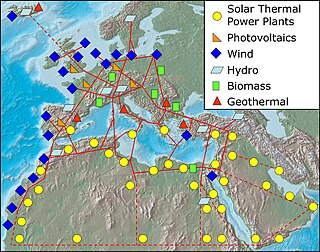
The SuperSmart Grid (SSG) is a hypothetical wide area electricity network connecting Europe with northern Africa, the Middle East, and the IPS/UPS system of CIS countries. The system would unify super grid and smart grid capabilities into a comprehensive network. There are no planned locations for infrastructure or schedule explicitly for the SSG; the name is used to discuss the economic and technological feasibility of such a network and ways that it might gain political support.

An electrical grid is an interconnected network for electricity delivery from producers to consumers. Electrical grids consist of power stations, electrical substations to step voltage up or down, electric power transmission to carry power long distances, and lastly electric power distribution to individual customers, where voltage is stepped down again to the required service voltage(s). Electrical grids vary in size and can cover whole countries or continents. From small to large there are microgrids, wide area synchronous grids, and super grids.
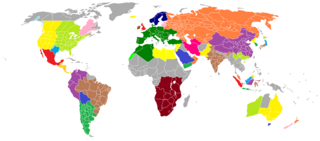
The IPS/UPS is a wide area synchronous transmission grid of some CIS countries, with a common mode of operation and centralized supervisory control. It has an installed generation capacity of 300 gigawatts, and produces 1,200 terawatt-hours (TWh) per year for its 280 million customers. The system spans eight time zones.

A super grid or supergrid is a wide-area transmission network, generally trans-continental or multinational, that is intended to make possible the trade of high volumes of electricity across great distances. It is sometimes also referred to as a "mega grid". Super grids typically are proposed to use high-voltage direct current (HVDC) to transmit electricity long distances. The latest generation of HVDC power lines can transmit energy with losses of only 1.6% per 1,000 km.
Inertial response is a property of large synchronous generators, which contain large synchronous rotating masses, and which acts to overcome any immediate imbalance between power supply and demand for electric power systems, typically the electrical grid. Due to the ever existing power imbalance between mechanical power supply and electric power demand the rotational frequency of the rotating masses in all synchronous generators in the grid either speed up and thus absorb the extra power in case of an excess power supply, or slow down and provide additional power in case of an excess power demand. This response in case of a synchronous generator is built-in into the design and happens without any external intervention or coordination, providing the automatic generation control and the grid operator with valuable time to rebalance the system The grid frequency is the combined result of the detailed motions of all individual synchronous rotors in the grid, which are modeled by a general equation of motion called the swing equation.
An interconnector is a structure which enables high voltage DC electricity to flow between electrical grids. An electrical interconnector allows electricity to flow between separate AC networks, or to link synchronous grids. They can be formed of submarine power cables or underground power cables or overhead power lines.

The electrical power grid that powers Northern America is not a single grid, but is instead divided into multiple wide area synchronous grids. The Eastern Interconnection and the Western Interconnection are the largest. Three other regions include the Texas Interconnection, the Quebec Interconnection, and the Alaska Interconnection. Each region delivers power at a nominal 60 Hz frequency. The regions are not usually directly connected or synchronized to each other, but there exist some HVDC interconnectors. The Eastern and Western grids are connected via seven links that allow 1.32 GW to flow between them. A study by the National Renewable Energy Laboratory found that increasing these interconnections would save energy costs.

The National Grid is the high-voltage electricity transmission network in India, connecting power stations and major substations and ensuring that electricity generated anywhere in India can be used to satisfy demand elsewhere. The National Grid is owned, and maintained by state-owned Power Grid Corporation of India and operated by state-owned Power System Operation Corporation. It is one of the largest operational synchronous grids in the world with 417.68 GW of installed power generation capacity as of 31 May 2023.

Synchronverters or virtual synchronous generators are inverters which mimic synchronous generators (SG) to provide "synthetic inertia" for ancillary services in electric power systems. Inertia is a property of standard synchronous generators associated with the rotating physical mass of the system spinning at a frequency proportional to the electricity being generated. Inertia has implications towards grid stability as work is required to alter the kinetic energy of the spinning physical mass and therefore opposes changes in grid frequency. Inverter-based generation inherently lacks this property as the waveform is being created artificially via power electronics.
In an electrical grid, the short circuit ratio is the ratio of the short circuit apparent power (SCMVA) in the case of a line-line-line-ground (3LG) fault at the location in the grid where some generator is connected to the power rating of the generator itself (GMW). Since the power that can be delivered by the grid varies by location, frequently a location is indicated, for example, at the point of interconnection (POI):
